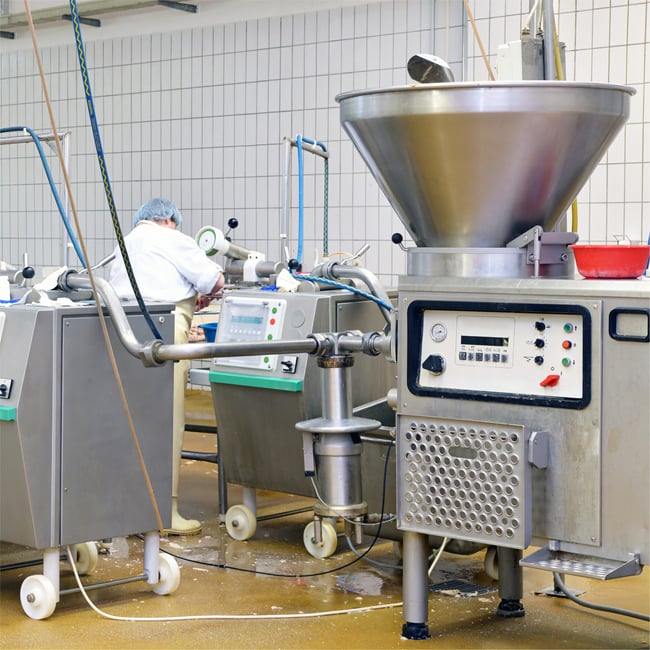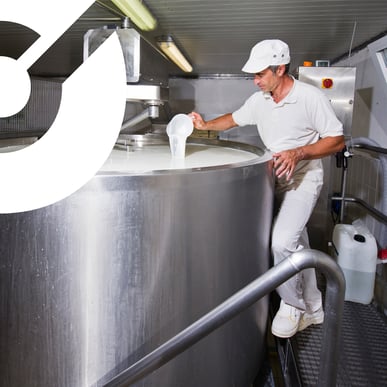Centrifuges are an essential part of every dairy plant — without them, we wouldn’t have many of the dairy products sold on shelves today.
So what do centrifuges do within the dairy production process? Let’s dive deeper.
Different uses for dairy centrifuges
There are two main uses for centrifuges in dairy plants:
- Milk (hot or cold)
- Whey
These two products make up about 80% of the dairy industry’s centrifuge uses. But plants may also use separators to produce:
- Lactose
- Quark (or Greek yogurt)
- Butter (specifically butter oil extraction)
Why do plants centrifuge milk?
Nearly all milk that is sold in stores goes through a centrifuge. This process separates milk into skim milk and cream. If producing skim milk, the milk goes on to be pasteurized. If producing milk with higher fat content, butterfat is added back in to produce 1%, 2%, or whole milk.
What happens in a milk cream separator?
Let’s break down what happens when raw milk arrives at a dairy plant.
Step 1: Raw milk (3.8%–4% fat content) arrives at the dairy plant
Step 2: The raw milk goes into the separator
Step 3: The raw milk goes into the centrifuge bowl
Step 4: The raw milk goes into the feed zone
Step 5: The raw milk is drawn up the rising channels
Step 6: Separation occurs, with skim milk (specific gravity of 1) going toward the outside of the bowl, and cream (specific gravity of 0.82) going inward where it exits the bowl
Step 7: The skim milk goes to standardizing, where fat is added back in to create the desired product (i.e., 1% milk, 2% milk, whole milk)
Step 8: The milk is homogenized under high-pressure pumps, pressurizing the milk up to approximately 4,000 PSI and stabilizing the milk so that fat cannot separate
Step 9: The milk goes to the heat exchanger for pasteurization
Separating hot milk vs. cold milk
By heating the milk proteins, there is less buildup and a lower viscosity. As a result, most plants run hot milk through their separators because it allows them to run higher capacities and meet their production volumes. The majority of milk that is sold at the grocery store has been heated before the separation process.
When processing cold milk, centrifuge capacity is cut by about 50% due to the high viscosity of the milk. This means it can take nearly double the amount of time to separate.
For example, our Alfa Laval HMRPX 618 HGV can separate 70,000 lbs/hr of hot milk daily, but it can separate only 35,000 lbs of cold milk per hour. Not only does that mean a plant processing cold milk will have lower production volumes, but it will drastically increase the time and number of centrifuges needed to process the same volume as a plant processing hot milk.
What happens when milk is denatured?
Plants that choose to run cold milk through their separator are usually avoiding denaturing, which occurs when you heat milk. The proteins in milk are heat-stable but denature below a pH 4.6. While denaturing milk proteins cuts the run time in a separator, it also impacts the vitamin and proteins in the milk, which in turn can alter the flavor of the milk.
What to look for in a used or remanufactured dairy separator
When buying a used or remanufactured centrifuge for your dairy plant, there are several factors to consider.
For plants that run cold milk, you’ll want to consider the cold milk disc stack.
For plants that run hot milk, you’ll want to look for a hot milk disc stack, which is thinner and has thinner caulks than cold milk disc stacks.
You’ll also notice that hot milk and cold milk separators have different pumps to process the differing viscosities.
Regardless of whether you run hot or cold milk through your production line, buying a remanufactured centrifuge can help you save money without sacrificing speed or performance.

How do centrifuges work?
While centrifuges all operate under the same principle, the process changes depending on the product being produced.
How do centrifuges separate whey?
About 75% of the cheese produced in the world is made by mega plants that produce popular types of cheese such as cheddar, pepper jack, and other common varieties you find at the grocery store. As a result, these plants are responsible for producing a large percentage of whey (a byproduct of cheese that is high in proteins and used across a wide range of industries).
To produce whey, large plants start with their cheese-making process:
Step 1: Milk (often skim) goes into a separator
Step 2: The milk goes into a vat
Step 3: The vat receives rennet, flavoring, and colors. The vat’s temperature activates the rennet to make cheese.
Step 4: The product goes to the curd tables and/or the DMC belt, where whey stream runoff drops off the belt
Step 5: The whey stream goes through fine savers to remove any remaining cheese fines in the stream
Step 6: The whey stream (containing up to 0.5% fat) goes into a silo
Step 7: The whey stream goes into the separator at a given flow rate to separate the whey phase from the cream phase
Step 8: Cream is recovered and either reused to make the same type of cheese or sold off (most often to make butter oil)
Step 9: The whey goes into a filtration system, then into dryers for spray drying to create whey powder
At smaller cheese plants, which produce about 25% of the world’s cheeses, they might separate and produce their own milk, or they might buy milk and have it delivered to their plant. They may also sell their whey to another plant, which will finish the drying process to create whey powder.
How do centrifuges separate lactose?
Whey streams contain lactose crystals that are formed during the creation of milk and cheese. To separate lactose, dairy plants:
Step 1: The whey stream is crystallized in crystallizers (which is done by dropping the temperature of the stream to 35–40 degrees Fahrenheit, resulting in the lactose falling out)
Step 2: The liquid stream runs through horizontal decanters
Step 3: Lactose in the liquid stream is released through G-force in the centrifuge and exits the separator as a solid (typically around 70% solid, 30% moisture)
Step 4: Lactose runs into dryers to make lactose powder
How do centrifuges separate quark/Greek yogurt?
Most plants that make Greek yogurt separate their own milk using a hot milk separation process. From there, the plant will then:
Step 1: Add rennet to culture the milk
Step 2: Hold the mixture for a certain length of time until it meets a pH value between 4.6 and 4.7, then break the hold
Step 3: Run the mixture directly into a nozzle separator
Step 4: Whey phase enters a discharge centrifuge
Step 5: Product comes out of the nozzles (Greek yogurt)
Step 6: Whey phase goes into a filtration system to be dried and sold as whey powder
Maintaining your dairy centrifuge
The key to a long life for your centrifuge — and hitting your production volume goals — is regular centrifuge maintenance.
Separators services dairy centrifuges across the U.S. Because we specialize in dairy and understand the unique needs of the industry, we:
- Offer emergency service calls 24/7
- Have extensive experience working on both Alfa Laval and Westfalia equipment
- Have over 4,000 centrifuge parts in stock, keeping downtime to a minimum
- Carry the appropriate insurance requirements for dairy plants
- Take customer service seriously and will work closely with you to get your plant back to optimal performance
Ready to partner and improve your dairy plant’s centrifuge performance?

